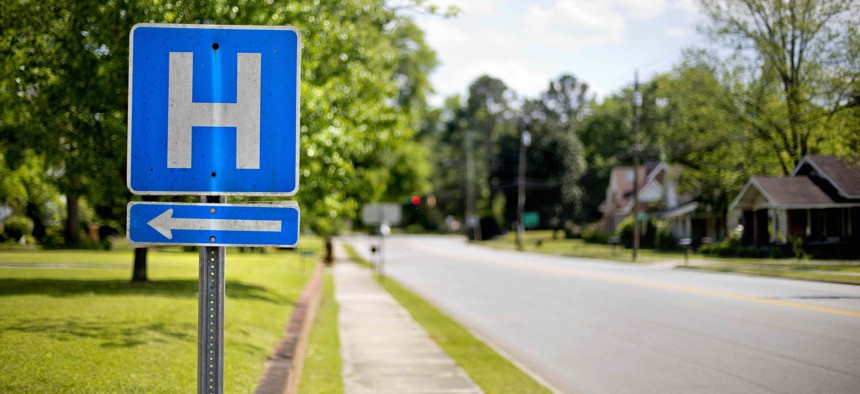Hospital Closures in Rural Areas Linked With Uptick in Inpatient Deaths, Study Finds

In this April 25, 2014 photo, a sign points the way to Flint River Hospital which closed its emergency room in 2013, in Montezuma, Ga. AP Photo/David Goldman

Connecting state and local government leaders
New research focused on California finds that hospital closures in urban areas didn’t have the same effect.
Rural hospital closures contribute to an increase in the number of inpatient hospital deaths from certain ailments, whereas urban closures do not, based on estimates presented in a recent research paper that analyzes 92 California hospital closures.
Dozens of rural hospitals around the U.S. have closed over the past decade due to financial strains, population shifts and other factors, raising concerns that people in areas once served by these facilities will be worse off when it comes to accessing health care.
The analysis of how rural hospital closures in California affected in-hospital deaths is detailed in a working paper authored by two University of Washington researchers.
Estimates in the paper suggest that rural hospital closures increase inpatient deaths by 5.9%. Urban closures did not have a significant effect on in-hospital deaths. There also was not a measurable impact when all the closures were assessed together.
“I think that the primary takeaway from the study is that rural closures and urban closures are different and they should be studied differentially,” said Kritee Gujral, a postdoctoral fellow at UW's Department of Pharmacy, and one of the paper’s authors.
“There is an impact that we find for rural closures that was just something that had not been found before,” she added.
Rural closures, Gujral noted, affect not only rural places, but also urban areas that may face increased pressure on hospitals after rural facilities close their doors. “There are spillover effects,” she said.
Gujral and her co-author, Anirban Basu, a professor of health economics at UW, point out in their paper that previous studies on hospital closures tend to treat all of them alike, regardless of whether they occur in urban or rural areas.
Their research examines the effects of 16 rural and 76 urban hospitals that shut down in California between 1995 and 2011.
It includes Medicare and non-Medicare patients diagnosed with strokes, heart attacks, asthma, a category of lung diseases known as chronic obstructive pulmonary disease, and sepsis, which is a condition that results from certain infections.
These ailments were selected in part because delays in care due to longer travel times to hospitals, or hospital overcrowding, can worsen outcomes for people dealing with them. Unlike other time-sensitive conditions, they also allowed for comparisons with prior research.
Gujral explained that California made sense to study because data that could be used for the analysis was easier to get a hold of there than it is in other states.
For the purposes of the study, patients were considered to be “affected” by a hospital closure if their residential zip code was part of a “Hospital Service Area” that experienced a closure.
Because the analysis looks at inpatient deaths, and not out-of-hospital mortality, or adverse outcomes that aren’t fatal, the researchers say they’re using a relatively conservative metric.
The paper does not focus on policy options for areas affected by hospital closures.
But Gujral said that two things policy makers may want to consider are how to manage spillover effects from rural closures on hospitals in urban areas, and how to address problems people might face traveling farther for medical care after a hospital in their area shuts down.
As for where the research will lead next, Gujral said she’s looking closer at the effects of closures across a range of different medical conditions, as well as trying to gain access to data for southern states where hospital closures have been prevalent.
It would also be useful, she said, to parse out how much different elements like ambulance travel times, or hospital overcrowding, contribute to negative outcomes like those highlighted in the paper.
The Sheps Center, at the University of North Carolina at Chapel Hill, tracks rural hospital closures and says that between 2010 and Aug. 7 of this year, 113 of the facilities have closed.
In 2017, there were about 2,250 general acute care hospitals nationwide that were located in areas that met Federal Office of Rural Health Policy’s definition of rural, according to a U.S. Government Accountability Office report from last August.
These rural facilities, the report said, accounted for about 48% of the nation’s hospitals and 16% of overall inpatient beds.
Bill Lucia is a Senior Reporter for Route Fifty and is based in Olympia, Washington.

NEXT STORY: Controlling Mosquito Populations by Releasing Mosquitoes





